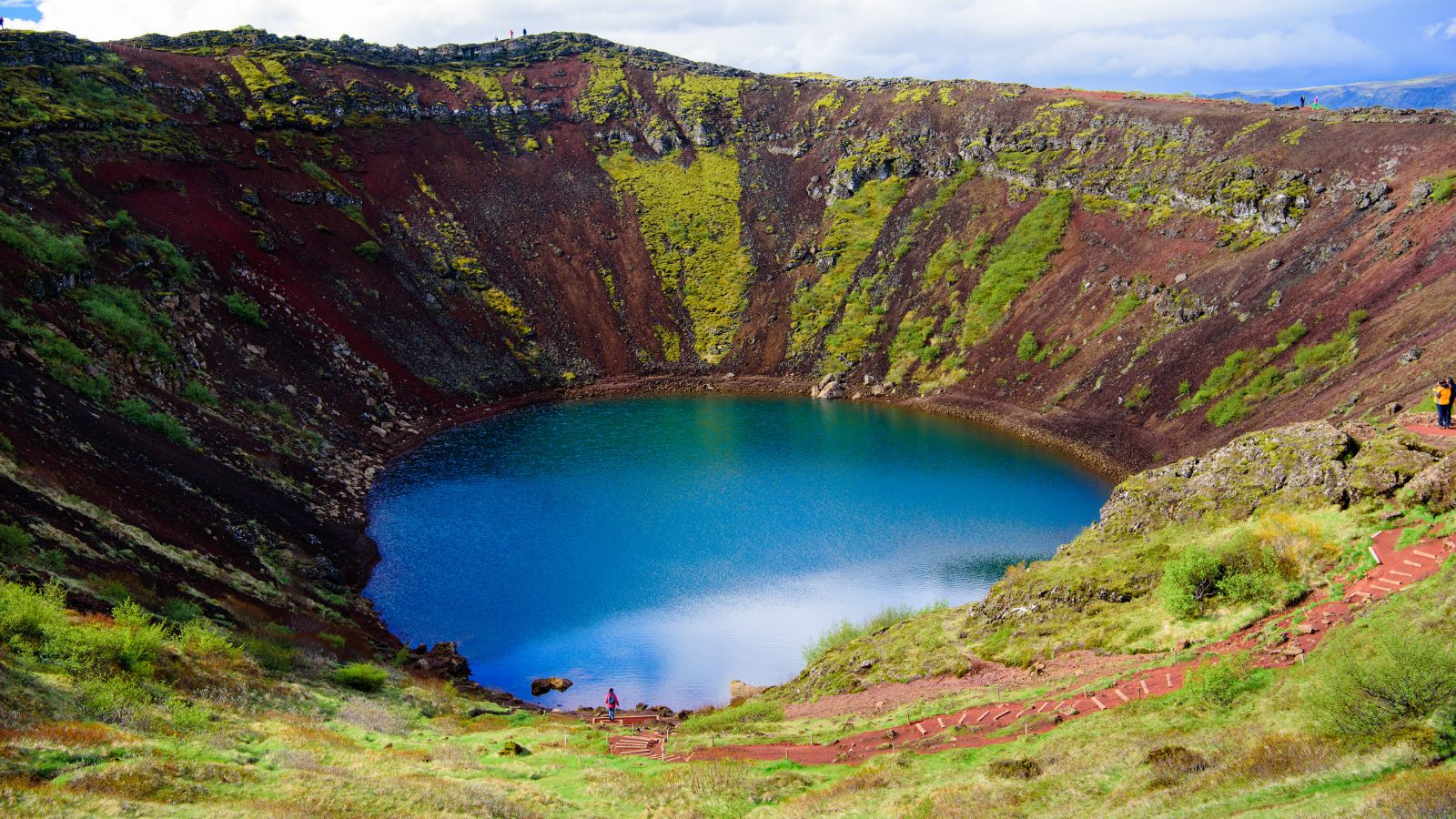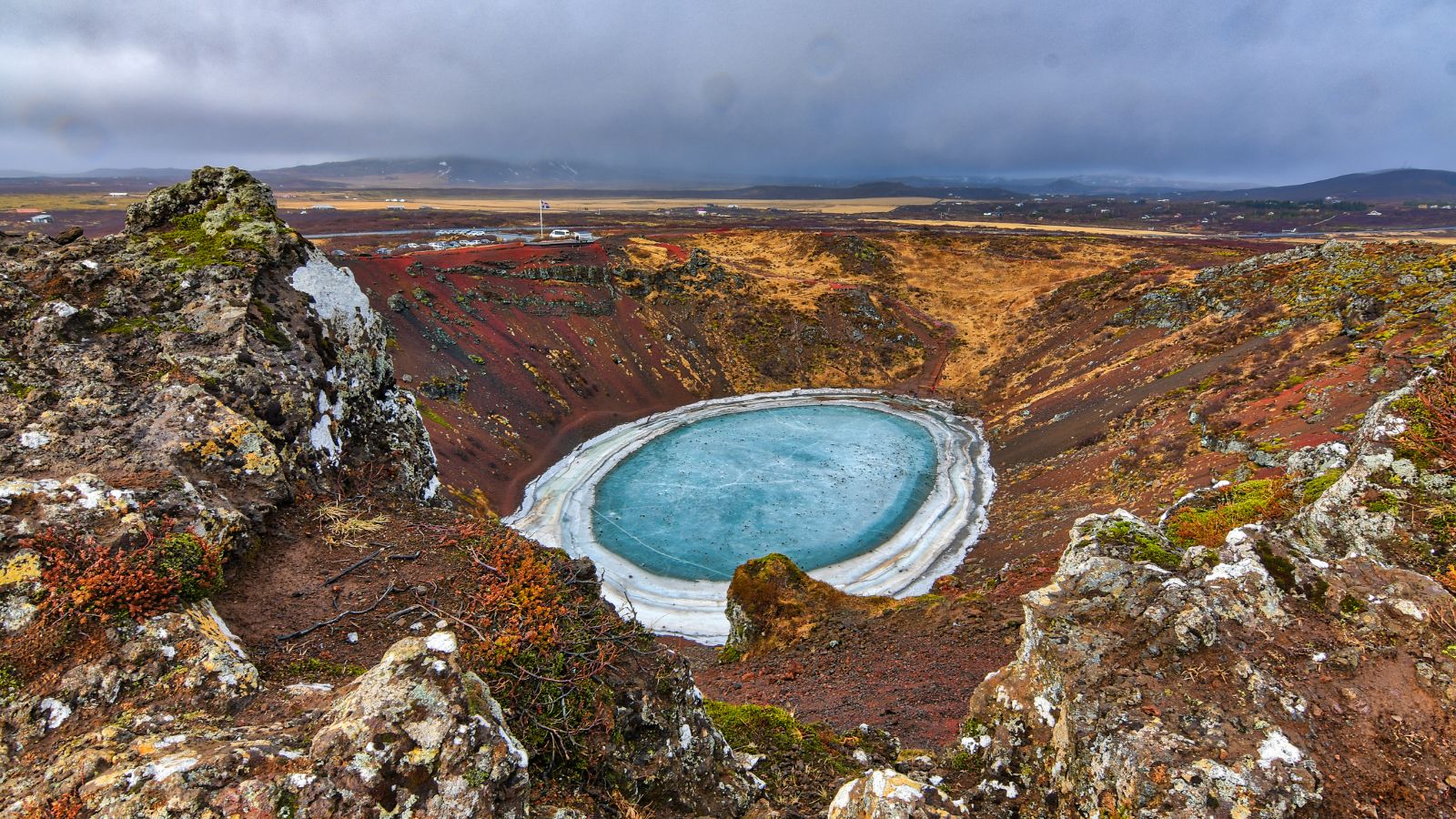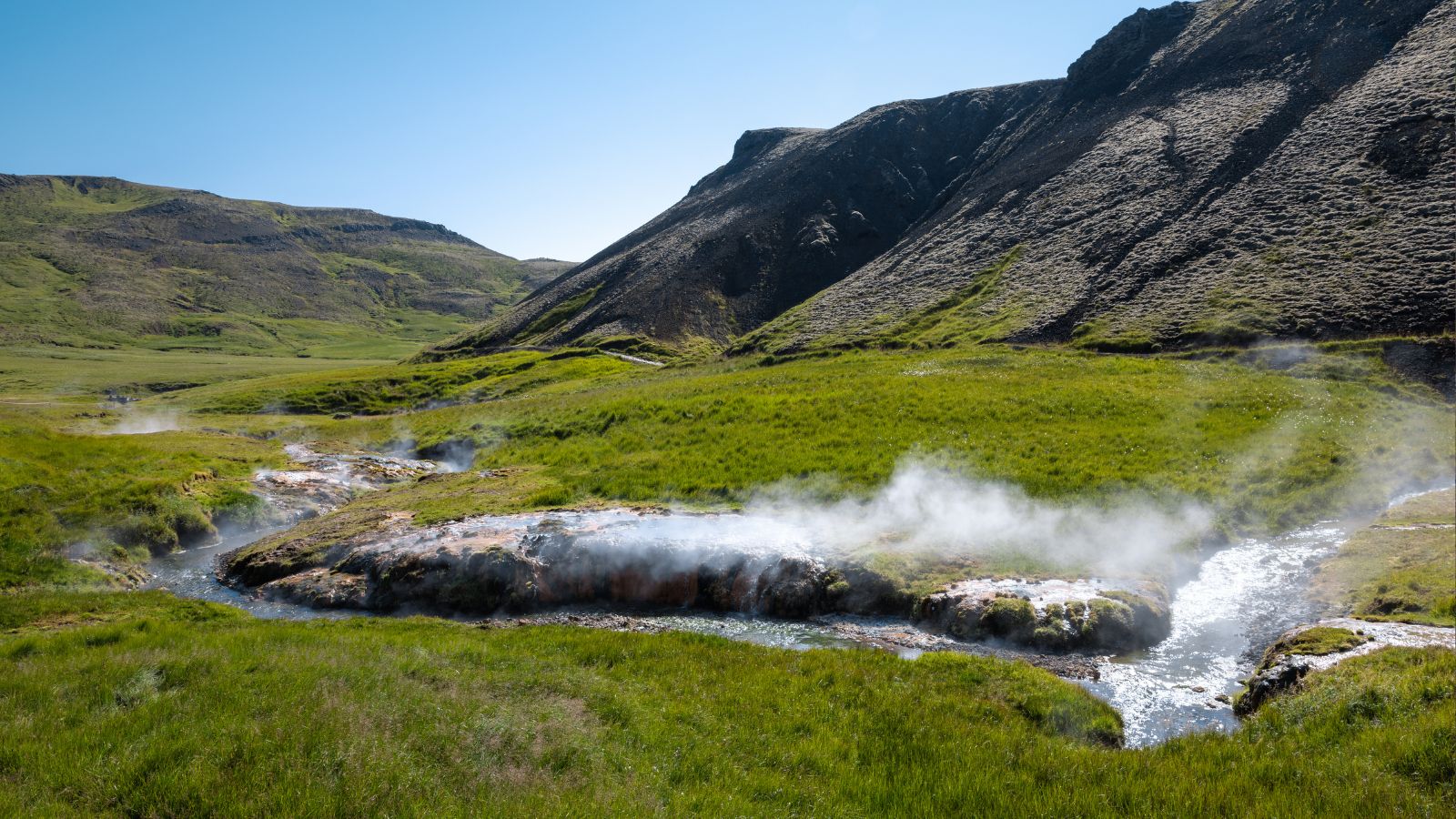This website uses cookies to help you browse on the website/ web. By using the website you agree on our policy on cookies.
Close
Kerid Crater Travel Guide

Located just a short way off Iceland’s scenic Golden Circle route is the stunning Kerid Crater. As one of Iceland’s most visually striking natural wonders, this vivid volcanic crater and lake make for a striking scene. Turquoise waters against red lava rock is a unique contrast you’re unlikely to see in many other places across the globe.
Here, we’ll tell you everything you need to know about Kerid Crater, from its fascinating geological past to how to get there and what else to see nearby.
What is Kerid Crater?
Kerid Crater is a striking volcanic caldera, located in the South of Iceland. It is best known for its vibrant red slopes and the aquamarine waters that fill the basin. Unlike the majority of Iceland’s older geological formations, Kerid is relatively young, having been formed about 6,500 years ago. This is in part why the crater is so visually stunning - the volcanic rock is still rich in iron, meaning that it hasn’t faded over time, which gives it the deep red hues we see today.
Kerid Crater is about 55 meters (180 ft) deep and 170 m (560 ft) wide. There’s also a footpath that allows visitors to walk around the rim or venture down to the water’s edge. Kerid is part of a larger group of volcanic craters, known as the Tjarnarhólar crater row.
Formed during a volcanic eruption millennia ago, Kerid differs from explosive caldera because it most likely collapsed into an empty magma chamber rather than blowing apart violently. This is what has given Kerid its perfectly oval shape, almost making it look like it was intentionally carved.

Where is Kerid Crater Located?
Kerid Crater is located in South Iceland, along Route 35 in the Grímsnes area. It’s perfectly positioned near the famous Golden Circle - a popular sightseeing route that includes Þingvellir National Park, the Geysir Geothermal Area, and Gullfoss Waterfall. This convenient location makes Kerid Crater a popular detour along the Golden Circle route.
The crater is located just off Route 35, one of the main routes used for Golden Circle travel. Kerid is very easy to find, and you’ll see plenty of clearly marked signs pointing you in the right direction. There is a small car park just next to the site, which is easily accessible year-round. It’s always a good idea to check road conditions when traveling in the winter, though!
If you’re driving from Reykjavík, it only takes a little more than an hour to reach Kerid Crater, which is located about 40 miles away from the capital. Our hire cars are the perfect way to get there!
When is the Best Time to Visit Kerid Crater?
Kerid is open to visitors year-round, and each of the seasons offers a unique experience. The best time to visit fully depends on what you’re looking for, but no matter when you visit, you’re guaranteed to have an unforgettable time. Just make sure to address appropriately for the season and always check road conditions on road.is. Here, we’ll explain a bit more about what to expect at Kerid at different times of the year.
Kerid in the Summer (June - August)
Best for: Easy driving, long daylight hours, clear views, and colorful photography.
With long daylight hours and warmer weather, it’s probably not surprising that summer is the most popular time to visit Kerid Crater. The trails around the crater and to the lake at the bottom are dry and easy to navigate, which makes it a friendly time for people of all abilities to visit. However, because of its popularity in summer, this is also the busiest time to visit. So if avoiding crowds is important to you, perhaps choose another season to visit.
Kerid in the Autumn (September - October)
Best for: Fewer tourists, warm tones in the landscape, and tranquil walks.
As autumn descends upon Iceland, so too comes the golden glow associated with the harvest season. Kerid Crater sees fewer crowds at this time, lending a quieter atmosphere for those who do plan to visit at this time. Road conditions are still generally absolutely fine, but again, always check before you travel.
Kerid in Winter (November - March)
Best for: Winter photography, frozen landscapes, and a quieter experience.
During the winter, Kerid Crater transforms into a frozen winter landscape, offering true peace to those who want a quiet experience. The lake often freezes over, and the surrounding slopes are not strangers to dustings of snow. The contrast of the white snow against the dark waters and red rock creates an ethereal scene that you won’t soon forget. Due to ice, walking paths can become slippery and potentially dangerous, so we always exercise caution if you plan to visit at this time of year. You may also want to bring sturdy footwear or crampons to help with any icy surfaces. The roads should still be fully accessible, even in the winter, but you could always opt for a 4x4 for added peace of mind.

Kerid in Spring (April - May)
Best for: Mild weather, early greenery, and shoulder-season calm.
Spring is a transitional period in Iceland, and conditions can vary from snowy to sunny in a single week, thanks to the island’s unpredictable weather. By May, the crater starts to bloom again with green moss and longer days. It’s an ideal time to visit before peak summer crowds arrive.
Can You Swim in Kerid Crater Lake?
As tempting as it may be to take a dip in the glimmering, jewel-toned waters at the bottom of the crater, unfortunately, swimming is not allowed at Kerid Crater Lake. There are a few key reasons for this:
- Kerid is a natural and protected site. People swimming in the water could disturb the delicate ecosystem within the lake or accelerate the erosion of the red volcanic slopes.
- The water in the lake is very cold, which doesn’t make for an enjoyable experience.
- It’s in the interest of your safety to not swim, as there are no lifeguards present.
Follow safety advisories on all signs posted in the area and stick to hiking the trail, taking photos, and enjoying the beauty of the crater instead of swimming.
Other Attractions Near Kerid Crater
As previously mentioned, Kerid is located just off the Golden Circle, meaning you can see some of Iceland’s most popular attractions in just a day or two. But there are other sites in the general vicinity that you may want to check out! Since swimming is prohibited at Kerid Crater, a couple of these options provide nearby alternatives if taking a dip is high on your list of priorities.
- Secret Lagoon: This natural hot spring has fewer crowds than the Blue Lagoon. It’s rustic, warm, and perfect for an authentic Icelandic bathing experience.
- Reykjadalur Hot Spring River: A geothermal area where you can bathe in a naturally heated river after a scenic hike.
- Selfoss: The town of Selfoss is only 15 minutes away from Kerid and is a convenient stop for fuel and supplies. It’s the largest town in the area and also offers a range of bakeries, supermarkets, and restaurants if you want to have a meal and do some exploring.

Now you’ve got all you need to plan the perfect adventure to Kerid Crater in Iceland. Our team is always on hand to handle any car hire queries you general Icelandic travel questions you may have. Don’t hesitate to get in touch!
Back